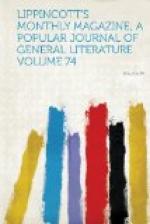In the time of Dutens (1777) the price of small stones of the first quality was one louis the carat; one and a half carats, five louis; two carats, ten louis; and beyond this weight no rule of value could be established. In De Boot’s day (1600) emeralds were so plenty as to be worth only a quarter as much as the diamond. The markets were glutted with the frequent importations from Peru, and thirteen years before the above-mentioned period one vessel brought from South America two hundred and three pounds of fine emeralds, worth at the present valuation more than seven millions of dollars. At the beginning of this century, according to Caire, they were worth no more than twenty-four francs (or about five dollars) the carat, and for a long time antecedent to 1850 they were valued at only fifteen dollars the carat. Since this period they have become very rare, and their valuation has advanced enormously. In fact, the value of the emerald now exceeds that of the diamond, and is rapidly approaching the ratio fixed by Benevenuto Cellini in the middle of the sixteenth century, which rated the emerald at four times, and the ruby at eight times, the value of the diamond. Perfect stones (the emerald is exceedingly liable to flaw, the beryl is more free, and the green sapphire is rarely impaired by fissures or cracks) of one carat in weight are worth at the present day two hundred dollars in gold. Perfect gems of two carats weight will command five hundred dollars in gold, while larger stones are sold at extravagant prices.
Most of our aqua-marinas come from Brazil and Siberia, and small stones are sold at trifling prices. Some of them, however, when perfect and of fine color, command fabulous sums. The superb little beryl found at Mouzzinskaia is valued by the Russians at the enormous sum of one hundred and twenty thousand dollars, although the crystal weighs but little more than one ounce. Another rough prism preserved in the Museum at Paris, and weighing less than one hundred grains, has received the tempting offer of fifteen thousand francs.
A.C. HAMLIN, M.D.
[Footnote A: A curious result happened to the elder Silliman when experimenting with a Peruvian emerald before the compound blowpipe. The reducing flame instantly melted it into a transparent green globule. Perhaps the intense heat of this all-powerful flame, which reduces even the diamond, recalled the colors which disappear at a lower temperature. But this could not be done if the color was due to organic matter, which is annihilated or modified beyond recall by combustion.]
[Footnote B: Several of the natural crystals of the Siberian emeralds of large size and beautiful color are now to be seen in the valuable and choice collections of Messrs. Clay and William S. Vaux of Philadelphia.]




